Build Custom Software with Ascendix
We help companies automate their workflow by developing bespoke software solutions. Leverage our experience in real estate, legal, financial, and transportation industries.
2 in 3 transportation executives state their companies are going through major transformations in logistics, supply chain, and asset management processes (Forbes). This means brands should increase efficiency within each module of operations to stay competitive, profitable, and revenue-driven.
Apart from the obvious challenges in the business landscape, the COVID-19 pandemic has set new trends in delivery. Just think of same-day shipping and other newly shaped market demands forcing vendors to shift their fleet management processes to retain existing customers and win a new target audience. However, many transportation providers still wonder how to evolve their operations and avoid increasing labor, vehicle maintenance, and fuel consumption costs.
Here comes fleet automation which helps mitigate financial risks and build efficient supply chain management workflows that would provide a business-customer balanced ecosystem for companies to transform and grow.
If you’re puzzling over the above-mentioned challenges and wondering how to improve fleet operations, keep reading to find out:
Fleet automation is about streamlining the 4 transportation management operations: data collection, analysis, task management, and process execution. Simply put, automation technology solutions take a good deal of jobs off your day-to-day plate.
First, fleet management systems automate data collection. It includes multiple vehicle-centric metrics managers should track to ensure delivery efficiency. Built-in truck OBD sensors automatically share many indicators like CEL, RPM, fuel pressure and consumption, speed, coolant temp, air-fuel ratio, freeze frame data, and many others.
It’s worth noting that an average transportation company collects, analyzes, and processes up to 25GB of vehicle data per hour for a single fleet (McKinsey Research). This means you should multiply 25GB by the number of your fleet trucks and then by active service hours per day. The total amount of data may reach up to several terabytes per operational day – unmanageable volumes for manual collection.
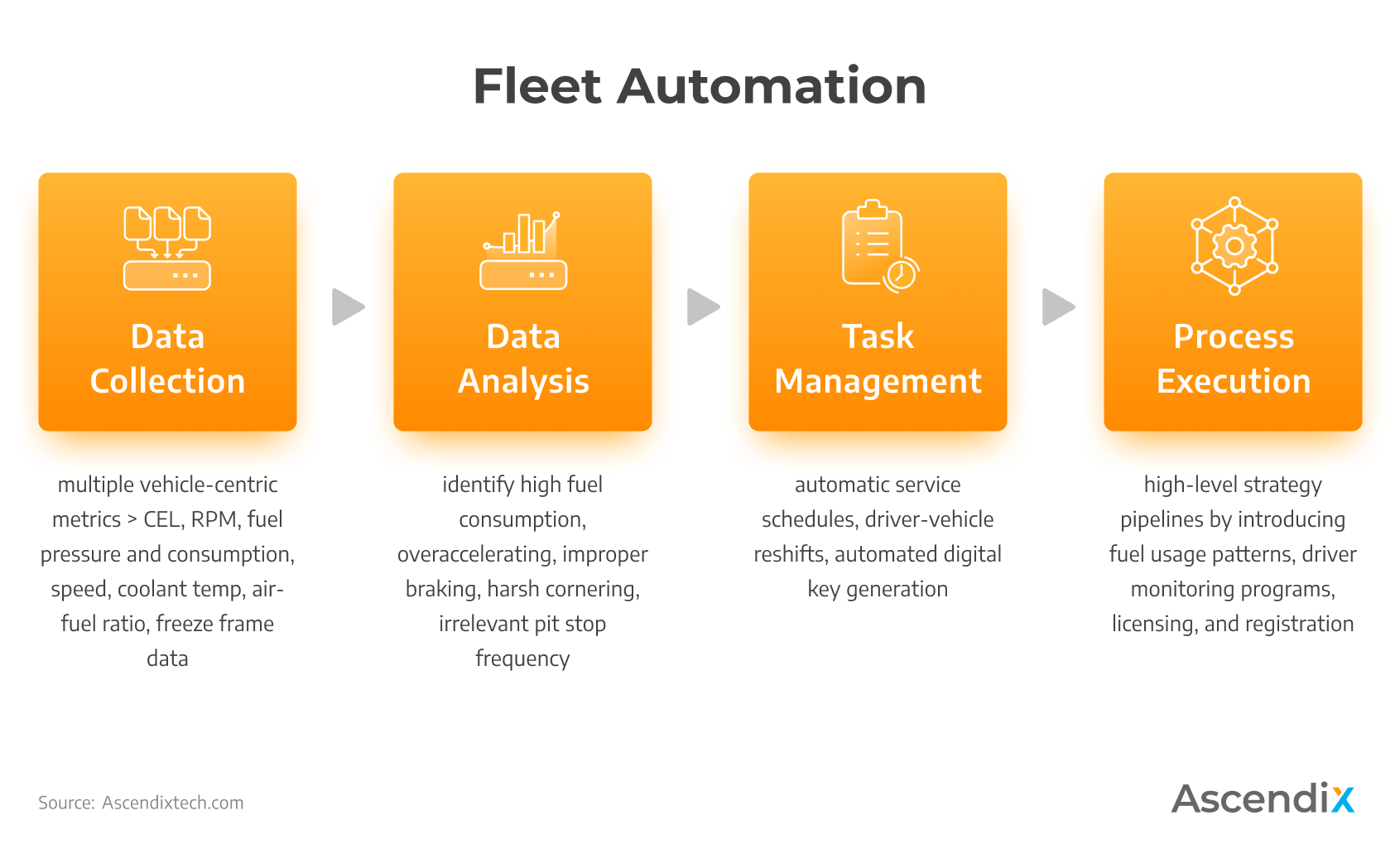
Fleet Automation: 4 Core Components
Second, operators need to analyze and assess this data for actionable insights and better decision-making. Technology systems help automate the transformation of raw data into ready-made reports so that managers can identify high fuel consumption, overaccelerating, improper braking, harsh cornering, irrelevant pit stop frequency, etc.
Third, this data-driven approach helps operators create tasks and rules and assign them to specific executives. Again, here comes automation which saves labor costs and lets managers focus on major tasks. For example, the collected vehicle data indicates that a specific truck needs service maintenance so that the system automatically schedules a service, reshifts a driver to another vehicle, and generates and safely shares a digital key to operate it.
Fourth, fleet automated solutions facilitate the execution of processes for managers. Apart from low-end vehicle service management, operators can automate high-level strategy pipelines by introducing fuel usage patterns, driver monitoring programs, licensing and registration, and many others.
We help companies automate their workflow by developing bespoke software solutions. Leverage our experience in real estate, legal, financial, and transportation industries.
Once transportation vendors decide to automate their fleet operations, they often opt for off-the-shelf solutions. Low initial costs, fast deployment and launch, and several UI customizations seem like a great initiative to invest in. However, it often turns out that the boxed software cannot facilitate ever-changing business demands that change daily. Below we discuss the core reasons why companies tend to switch from generic products to tailor-made systems.
Ready-made fleet management software vendors mostly offer multiple packages with different infrastructure specifications, number of users, and out-of-the-box features. However, companies often face the situation when the top plan doesn’t meet current needs and the platform vendor doesn’t provide individual adjustments.
This forces vendors to look for automated fleet systems that are tailored to their specific fast-changing demands and support quick adjustments and adaptation to the new business workflows. For example, a custom solution enables the company to release new updates and upgrades that extend the current missing set of features or integrations.
At first glance, generic software looks way cheaper than tailor-made systems that may take up to $200,000 to implement. That’s partially true as most companies don’t use about 65% of features included in a specific plan (Standish Group research). This means two-thirds of the costs companies spend on the subscription are wasted on something that will sit on a shelf untouched.
With a custom fleet management system, transportation vendors can fully control the money infusion and devote funds to implementing critical adjustments and additional features that solve real-time needs.
Transportation and logistics have become among the most targeted domains by cybercriminals since 2017 (Forbes) as companies collect and process tons of data daily. Sensitive customer-based data like personal addresses, phone numbers, credit card details, and other information should be encrypted with the most secured protocols.
Though many generic software providers offer anti-theft features, the chances are still high that your business-sensitive data may be hacked and stolen as it’s stored on the vendor’s side. The FleetNews stated that over 40% of UK-based fleet providers have identified different cyber attacks during the last 12 months.
Custom automated fleet solutions help embed the best-in-class security level by introducing such protocols as Triple DES, AES, RSA Security, Blowfish, Twofish, IDEA, HMAC, or even an evolving quantum cryptography algorithm. Having full ownership rights and control level, you can secure both business- and customer-specific data and avoid relying on a vendor’s third-party features.
Asset utilization is a critical make-or-break process for transportation companies as it may lead to both high profits and losses. This makes automating vehicle availability and driver management a must-have for small-to-medium fleets and large trucking vendors. The more effectively you adopt fleet resources, the more performance, and profitability you can get.
First, automation helps monitor and identify excess and deficiency of fleet vehicles to rearrange truck availability and mitigate potential risks in real-time. Also, collecting and analyzing resource availability helps to adjust the utilization scenarios in post-processing to avoid inefficient supply chain management in the future.
Second, automating vehicle availability and driver management is about building immunity to potential emergencies. For example, a driver may collapse during the delivery process which may lead to a shipment failure and missing customers’ timeframes. Here comes an automated vehicle and driver substitution algorithm which automatically rearranges executives and trucks based on current availability.
Third, automatic algorithms lead to efficient stuff time allocation as fleet managers spend much less time on manual rearranging and availability monitoring. In turn, this decreases the operating costs by streamlining labor efficiency.
Efficient route planning is a real game-changer for on-demand mobility service providers as it helps build the shortest optimized-only trips based on real-time changes including rearranged time windows, off-road conditions, traffic management, etc.
First, automated route planning with dynamic routing algorithms enables transportation companies to build streamlined trips given traffic conditions, current locations of vehicles, truck-specific road limitations, and others.
Second, companies can minimize the empty mile issues which mean driving an empty container which increases operating costs and decreases revenue per mile.
Third, automated to-the-minute shipment management allows for providing way more accurate ETAs for customers and minimizing delivery delays by analyzing current on- and off-road conditions.
Once managers get new order requests, they should process multiple factors like up-to-date driver schedules, vehicle availability, current time windows of customers, and truck loading metrics. Human factor risks and non-optimized stuff time allocation may cost you a fortune if processed manually. So, automation can serve you a great purpose.
First, managers can process new requests more efficiently and quickly backed by real-time vehicle availability and driver schedules.
Second, automation helps achieve optimized-only route allocation by automatically analyzing customer preferences and current fleet capabilities.
Third, managers can improve the truck loading process, boost delivery performance, and decrease cost-per-mile metrics by minimizing empty miles.
Real-time vehicle metrics are among the core shipment data to track and analyze. If processed manually, large fleets with 100+ trucks and even small-to-medium vendors with 20+ vehicles need to hire a dozen specialists to handle the incoming data. Instead, real-time delivery tracking automation is what saves your time and money.
First, it helps increase the accuracy of predicted ETAs for further trips and decreases a potential negative impact by timely fleet resource allocation in real-time.
Second, managers can get up-to-the-minute truck locations and guide drivers on fast-changing on- and off-road conditions along with tracking the order fulfillment process.
Hire Ascendix experts. Leverage our experience in real estate, legal, financial, and transportation industries.
The 3 key user groups are customers, managers, and drivers using platform functionality daily. Providing a full-scale set of features to each group directly impacts your platform’s efficiency and business profitability. Below we want to list the tried-n-tested functionality modules for each audience taking a bus ticket booking service as an example.
Note: we’ll also feature the purpose-wide platform functionality at the end so that you know basic functions that may be a must-have for your business operations.
Once a customer decides to utilize your shuttle bus service, they should be able to create a personal account through an easy sign-up/social login feature via a mobile/web app. Social logins help increase the click-to-registration ratio by 2x times and boost the user retention rate by 65% (SmartInsights). The most popular social login platforms are Google, Facebook, and Twitter.
During the registration process, you can add such required fields for users to fill in:
A personal user account allows customers to review trip schedules, book tickets, proceed with payments, view their trip history, make real-time booking adjustments, and get real-time support via a built-in chat.
As for your customer support team, personal accounts help track the number of active/inactive users, analyze behavior patterns, build effective marketing campaigns with personalized discounts, and create ICP-based loyalty programs.
Here are our designed mockups of registration/login screens for Flibco.com, one of Western Europe’s leading shuttle bus service providers.
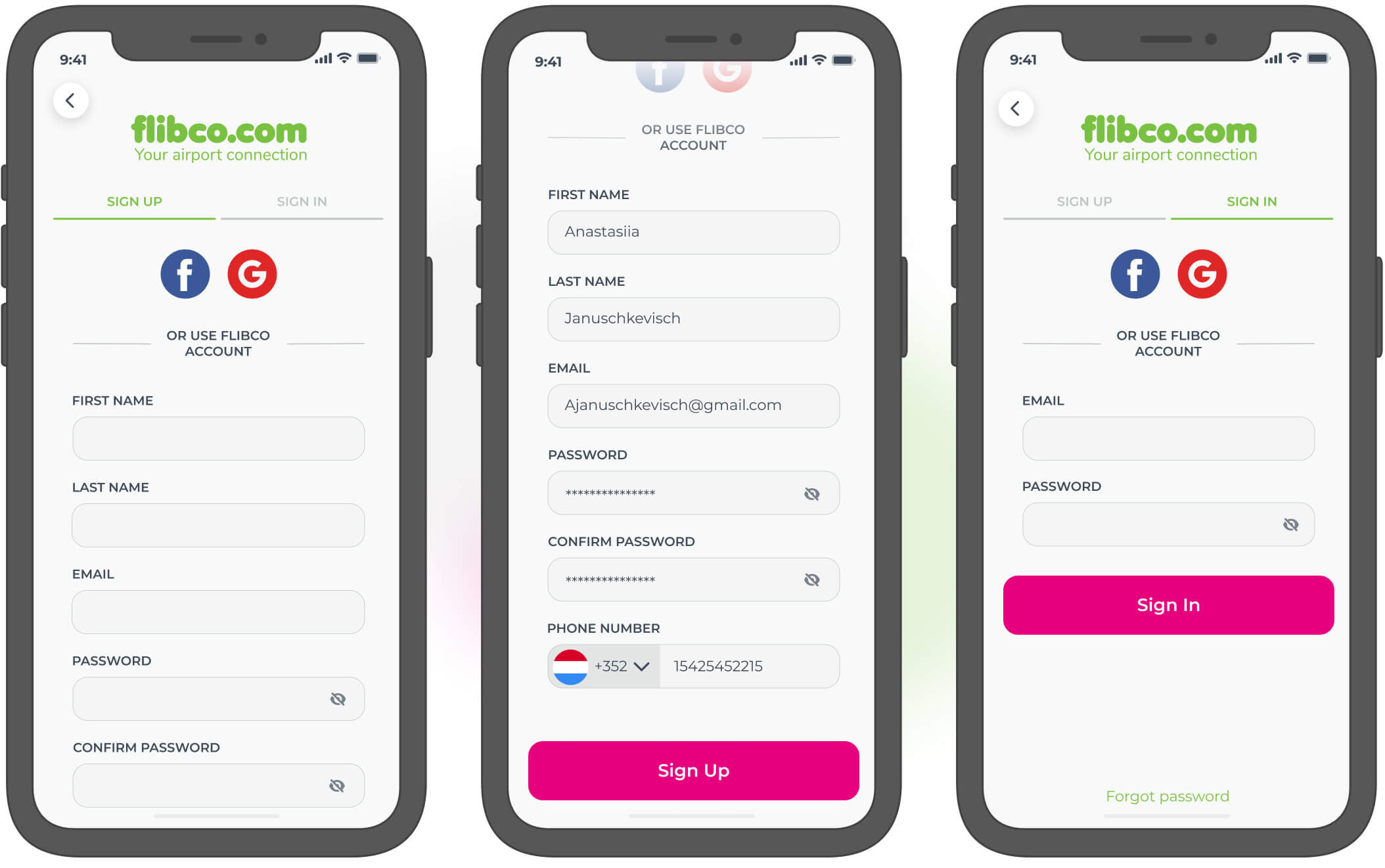
Flibco bus reservation system registration and social login | Ascendix Tech
When it comes to booking a ticket, customers need to have essential fields and user experience that meet their basic demands (at least). So, the ticket booking stage should allow users to choose:
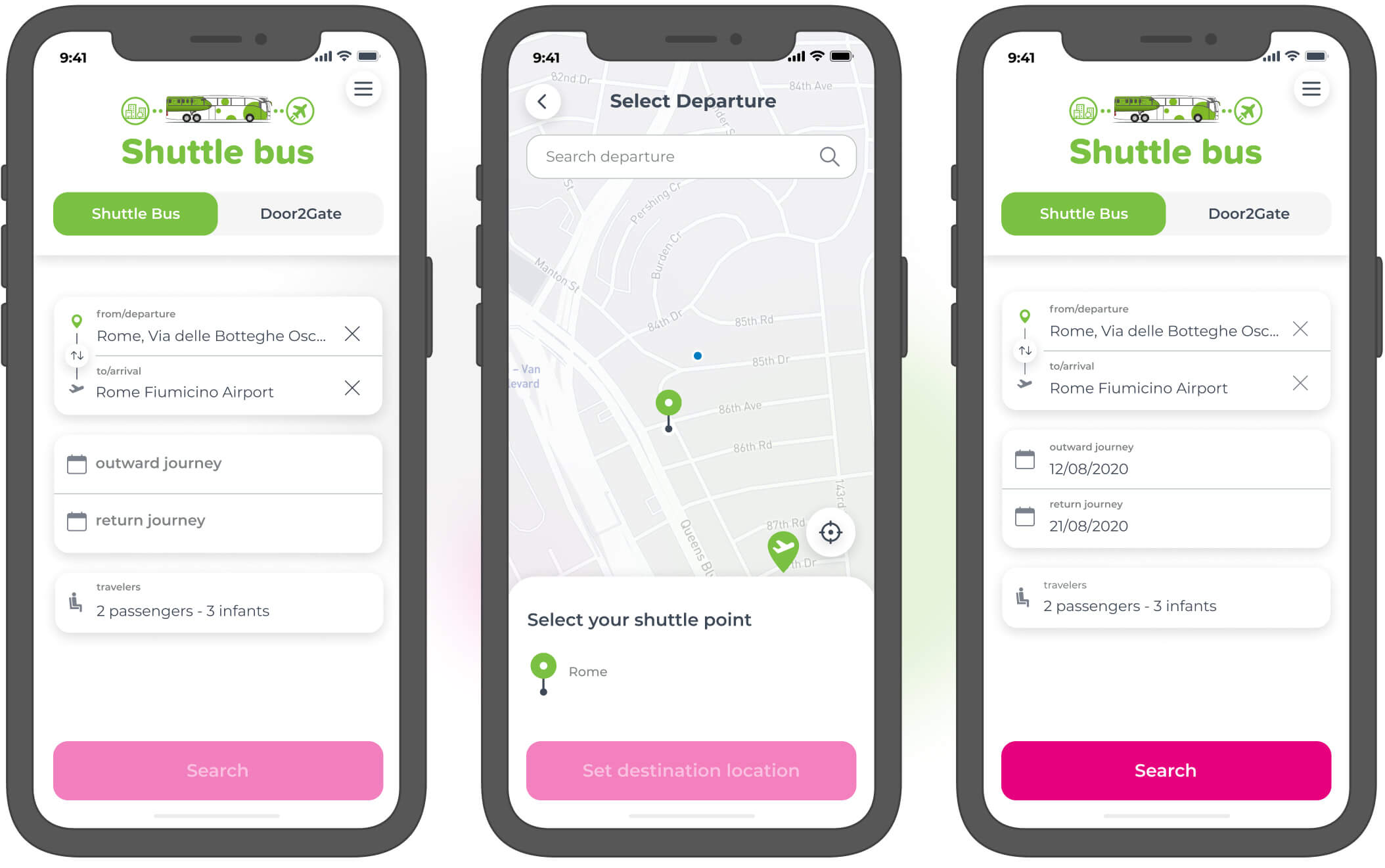
Departure/arrival and route screen of Flibco | Ascendix Tech
Once filled in, users need to choose a specific tour from a list of available data-based trips featuring timelines, prices, and route details. We developed the following functionality for Fibco.com:
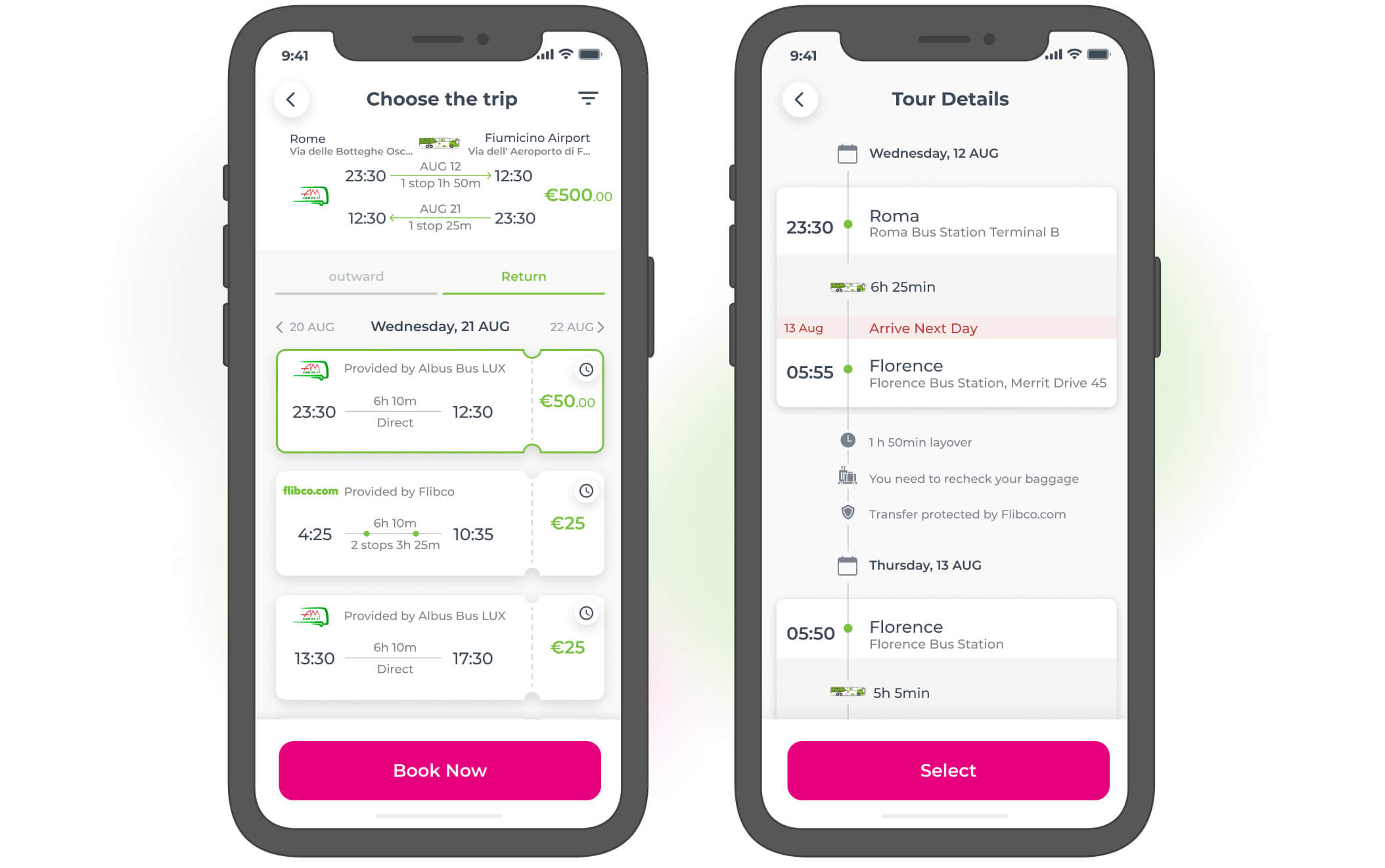
Tour choice and details for Flibco’s Bus Reservation System | Ascendix Tech
When clicking on a specific record, customers should see trip details including bus stops, station-to-station timings, total tour duration, etc.
Once users are all set with choosing a trip, navigate them to the checkout process. It validates ticket confirmation and lets customers choose the preferred payment option. We recommend adding several gateways as it helps increase revenue by a third on average (PR Newswire research).
According to Entrepreneur.com, the most in-demand payment services for the US- and European-based users are Paypal, Payoneer, Stripe, Apple/Google Pay, and Amazon Payments. Apart from digital payments, 2 in 10 users still prefer to pay using a cash-on-delivery option so add this option as well. At this stage, we recommend adding promo codes/coupons as a part of your marketing campaign so that users can get a discount by entering the code.
Once succeeded with purchasing a ticket, let users download an invoice right to their device or send it via the existing email address. It improves customer service as users will have tickets both in a mobile app and in their inboxes.
Here are designed checkout screens for Flibco.com:
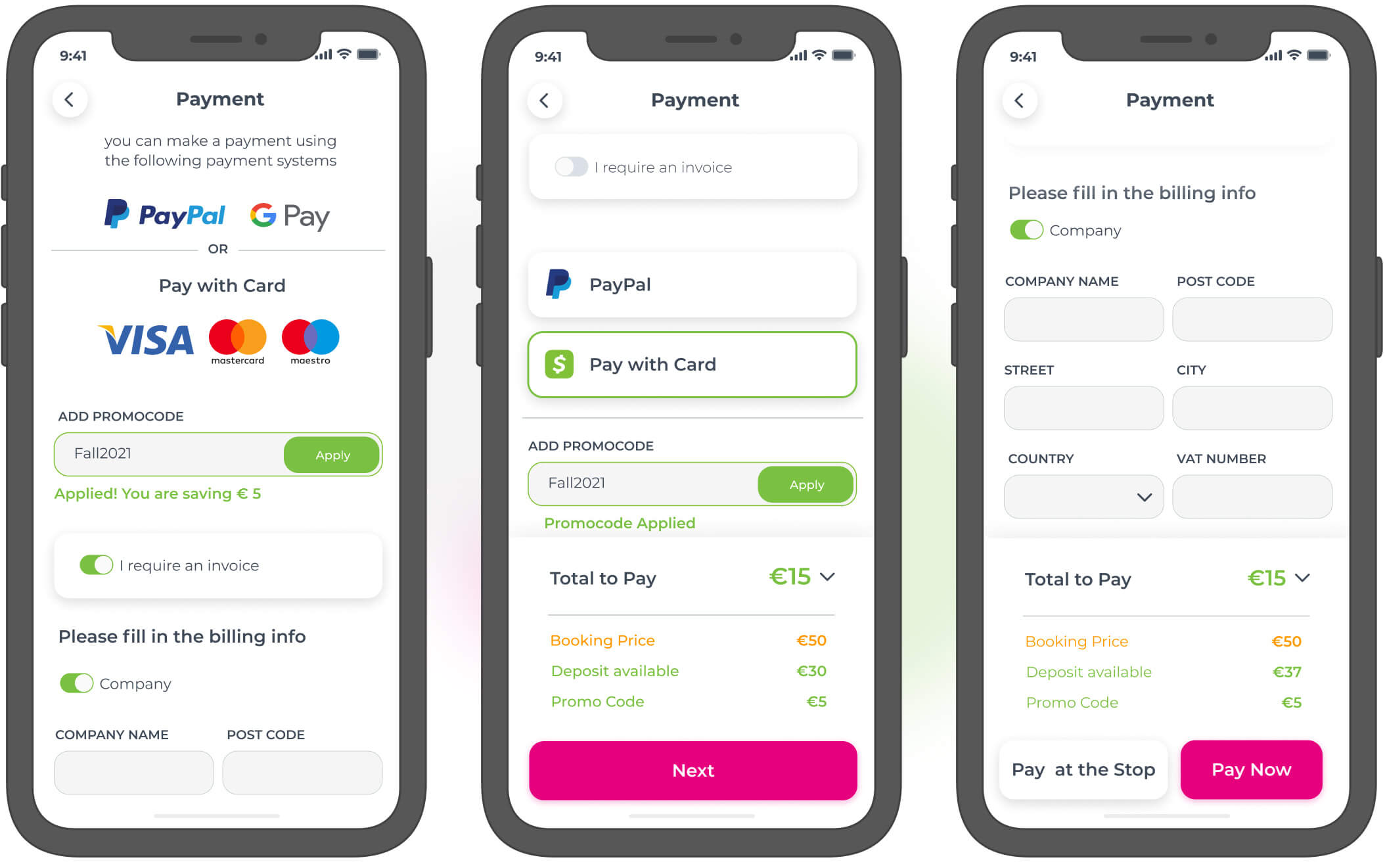
Сonfirmation and payment processes for Flibco’s bus reservation system | Ascendix Tech
Arrival/being late notifications are a must-have in any transportation/logistics subdomain for customers. It helps passengers avoid harsh weather conditions and excessive waiting times so that customers get to the station right before the vehicle arrives. Late alerts play the same role in informing passengers they can rearrange their current plans and avoid long waiting, decreasing customer satisfaction.
We recommend implementing both in-app, email push notifications, and SMS messages to eliminate “no signal” or “no service” cases.
62.8% of customers claimed real-time tracking gives them time back in their day and mitigates any worries about missing a trip, package, or excessive waiting for a delivery (OptimoRoute). More than that, over 1 in 3 customers stated they would be more likely to return to a brand that offers real-time tracking while 25% of surveyed users stated they would be extremely likely to return to the same brand.
The mentioned stats show this feature is nice-to-have or even a must-have if you want to build trust-centric relationships with your customers.
Fleet drivers use mobile applications which help automate tons of day-to-day shift routines and help both managers and executives eliminate manual operators. An app helps drivers access up-to-the-minute schedules, view tour details, get an automatically generated optimal trip route, and contact operators for getting real-time support via an online chat or by a call.
Executives perform tons of touring daily so a clear up-to-the-minute schedule is a must. It should share core data like day-to-day assigned tours, pickup/dropoff points, bus stops, estimated trip duration, etc.
Also, fleet operators frequently make real-time alterations or provide real-time updates, send notifications, and alerts, off-road conditions, dynamic route changes, etc. A mobile driver-centric app helps connect executives and managers through an online chat or via a call for instant cooperation.
Drivers can also perform additional passenger check-in to validate customers through a mobile application. Simply scanning generated ticket codes helps avoid unauthenticated logins and improves customer tracking. The automated system should transfer specific generated trip tickets to a driver’s mobile app so that the system can scan codes and identify trip passengers.
Real-time vehicle tracking is also a must-have feature for operators as they need to keep track of a truck’s location to ensure smooth bus tour performance. As we mentioned above, a single vehicle can produce up to 25GB of data per hour which makes it next to impossible for operators to handle the entire collected data manually.
The core real-time gathered metrics help operators create new rules and tasks to enhance bus tour efficiency, fuel consumption, decrease service costs, etc.
Real-time tracking is about facilitating drivers throughout the tour and guiding them on fast-changing off-road conditions like weather, traffic, and others. Also, operators can manage driver and vehicle availability in case of urgent changes and reassign drivers, and buses, and even rearrange tours according to the map zone availability if needed.
Real-Time Vehicle GPS Tracking by OnFleet
Once managers access up-to-the-minute driving information, they need automation to process it in a time- and cost-efficient way. Here comes analytics and reporting functionality which facilitates generating insightful reports that help perform both high-level strategies and low-end tasks for drivers.
First, this module helps managers identify unobvious and critical errors, mistakes, and find new growth points that may help decrease operational costs and boost supply chain management efficiency.
Second, operators can utilize smart analytics tools to collect, analyze, and process tour performance indicators for each tour, driver, or map zone weekly, daily, or even hourly. From average fuel consumption to on-time pickups/drop-offs, dispatchers can also generate PDF reports and share them with C-suite executives for further adjustments.
Third, fleet managers can utilize analytics and report generation tools to visualize data and validate KPI metrics set monthly, quarterly, or annually. The total number of tours, active drivers, pickups/drop-offs, claims-free percentage, DOT reportable safety incidents, cost-per-mile, revenue-per-mile, cost-per-stop, and many others. Thus, analytics and reporting tools help monitor and update KPI dashboards in real-time and encompass most of your transportation workflows to assess and improve on.
Here’s an example of analytics functionality by OnFleet.
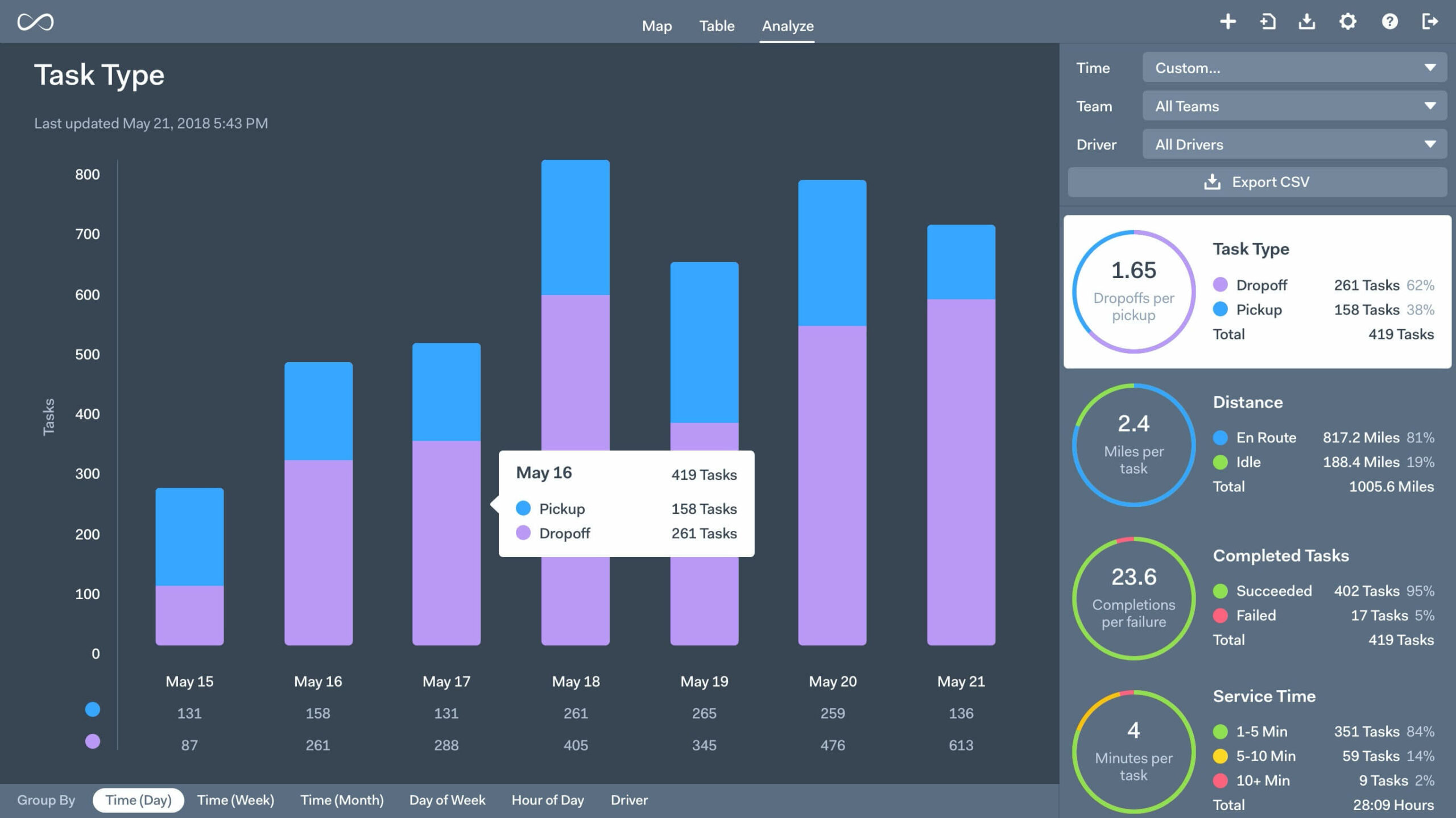
Insightful Dashboards with Analytics and Reporting by OnFleet
Management of bookings, schedules, and vehicle availability are day-to-day responsibilities of managers that have become commonplace. The larger a fleet becomes, the more time operators need to spend on routine pipelines handling even more data just to facilitate the existing performance level. So, fleet automated solutions come into play to bring automation which helps decrease labor costs and increase operator efficiency throughout the transportation pipeline.
First, managers need to take orders from customers, align them with current schedules, and assign available drivers according to their shifts.
Second, properly arranged schedules are a must-have for efficient transportation workflows, but processing dozens of them daily may become a hit and miss for medium and large fleets. Here come fleet automation algorithms for scheduling that take operators’ jobs off their plate.
Third, vehicle availability is a complex process as demand intensity and locations may fluctuate during an hour, day, or week. Careful fleet sizing, shift planning, and vehicle positioning are the cornerstones of efficient on-demand mobility services that avoid oversupplying (too many empty vehicles) and undersupplying (lack of vehicles). So, automated fleet management systems offer accurate and on-demand dispatching/routing capabilities that help operators manage vehicle availability the way both business and customers stay satisfied.
All in all, fleet automation solutions eliminate most potential human errors and not-so-obvious mistakes that may cost you a fortune.
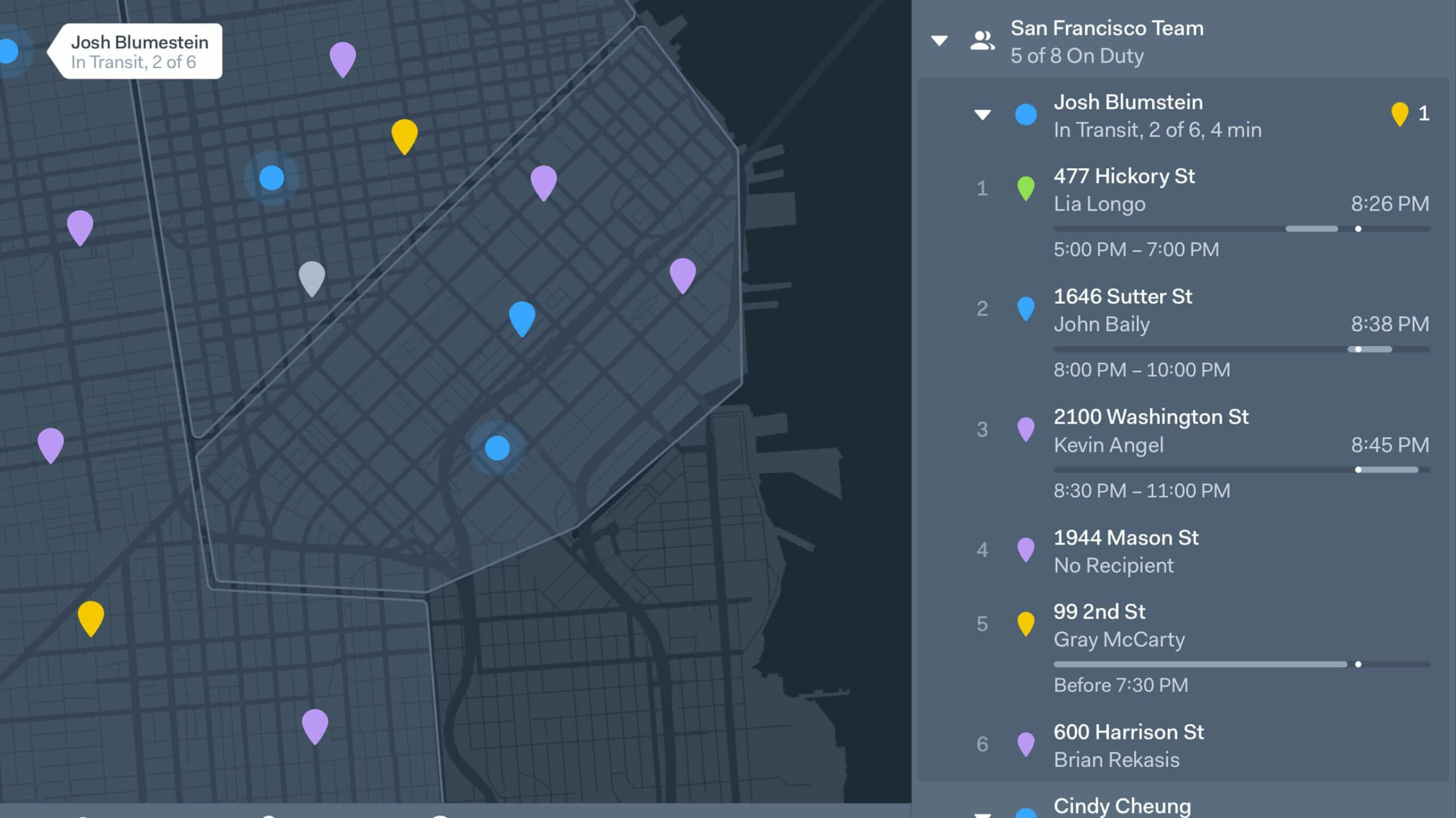
Proof of Delivery by OnFleet Vehicle Routing Software
When it comes to developing your own fleet automation solutions, there are multiple factors to consider that may impact the final platform costs. Here we want to discuss several technology solutions and approaches we recommend implementing to save time and expenses while making your platform an efficient and on-demand solution.
In the era of thriving cloud-based hosting and SaaS solutions, many companies still tend to develop automated fleet solutions using a dedicated server approach. Though it provides fixed allocation of isolated RAM, CPU, and SSD/HDD storage considered to offer better performance and enhanced security, there are still vivid drawbacks.
The core disadvantages of using dedicated server hosting are:
Cloud-based hosting makes a difference by offering easy deployment, high performance, support of updates, monitoring tools, loss prevention, and many others. In terms of security, 9 in 10 businesses claimed they noticed an improvement in security after switching from dedicated servers to cloud computing. More than that, over 90% of entrepreneurs stated it became easier to meet government compliance requirements with cloud-based systems.
The enhanced security becomes possible by encrypting data that is transferred over networks and stored in databases. This makes encrypted data way less accessible for non-authorized users not intended to view your business data.
Also, cloud-based solutions offer diverse flexibility enabling you to avoid data-storage activities and focus on meeting your business demands. In case you need extra bandwidth, a cloud-based provider can help you instantly so that you no longer need to perform a time- and cost-consuming IT infrastructure update. The InformationWeek report features that 2 in 3 respondents said: “the opportunity to reach business goals” was among the core drivers for businesses to choose cloud environments.
When building automated fleet solutions, the abstraction principle helps focus on critical processes while automating current operations. For example, different abstraction levels allow filling in just two fields – operation days and the number of service hours – to automatically generate driver schedules. Thus, it enables technical teams to avoid developing a separate financial accounting module for the same needs that lowers the total platform development costs.
Instead of creating costly detached reporting and analytics modules, you can leverage BI tools that provide full-featured functionality to build custom graphs and charts within your business data. Business intelligence services are a catch-all phrase that refers to transforming raw input data into visually-appealing and insightful views for better decision-making processes. The most thriving BI software providers are Microsoft, Oracle, SAS, DOMO, and Zoho.
As a technology advisor, we partner with small firms and global enterprises helping them bring automation to their operational processes.
For many years, Ascendix has been involved in delivering demand-specific transportation management software tailored to current business needs and designed to solve multiple vehicle routing problems of mobility service providers. Now we want to discuss a step-by-step case study on how we delivered a one-fits-all SaaS-based platform for one of the largest Luxembourg-based mobility companies.
So, the company initially contacted Ascendix to get tech-savvy professionals for building an all-in-one fleet operator software to:
Let’s now review the development process within a challenge-solution approach.
| Fleet Automated Management System: Challenges and Solutions | ||
|---|---|---|
| Before | After | Description |
| Shift driver idling waiting for the new trips. | Optimization of driving time utilization | We developed an algorithm that validates shift by shift to spot the emptiest ones, reallocate resources and replan routes by reassigning shifts. So, the client now has an optimized pipeline of driver shifts backed by efficient truck loading. |
| Drivers could perform only several shipments in parallel. | A multi-stop trip merger algorithm. | We designed a smart logic that automatically merges different routes in a single shared one with multiple stops. If the algorithm finds flow stops and empty timeframes, it merges orders to meet customers’ requirements like a preferred time window. Also, it helped evolve vehicle capacity and minimize carbon footprints. |
| Non-optimized route planning with inefficient fuel consumption. | Enhanced booking assignment algorithms | We implemented advanced booking assignment algorithms which calculate point-to-point distances for each route and suggest the most cost- and time-efficient trip for managers. It minimizes the total route time and optimizes fuel consumption. |
| Manual-only processing of orders which complicated the workflows of managers and didn’t allow them to follow the maximum driving time and break duration rules. | Fully automated driver management system | We developed a driver management system with smart dynamic breaks. It analyzes trip durations and automatically reschedules mandatory breaks to address the labor rules without any interruption. This helped streamline the booking pipeline making it loss-free. |
Apart from the above solutions, we’ve helped the company implement the following:
As a result, we’ve delivered a powerful mobility-on-demand system and one-fits-all fleet ecosystem which helped the client to optimize fleet performance and minimize idle time
Fleet automation is the purpose-serving solution for transportation companies puzzling over how to improve fleet management. Streamlined data collection, analysis, task management, and process execution transform manual-only day-to-day activities into data-driven automated pipelines. They mean on-demand mobility services providers no longer need to spend fortunes on manual administration as fleet automation solutions will do the heavy lifting.
If you’re about to evolve your own software tailored to specific business needs, Ascendix is here to help. Our transportation and logistics software development expertise can help you mitigate large operating costs and non-optimized supply chain efficiency creating a revenue-driven system. Just drop us a line and we’ll send an estimate.
Daniil specializes in content marketing and has a deep knowledge of promoting the company's products and services through high-quality content. On the Ascendix blog, Daniil shares his tricks and tips on custom software development, provides technology trends and insights, and helps you get valuable content to make your business even more successful and profitable.
Get our fresh posts and news about Ascendix Tech right to your inbox.